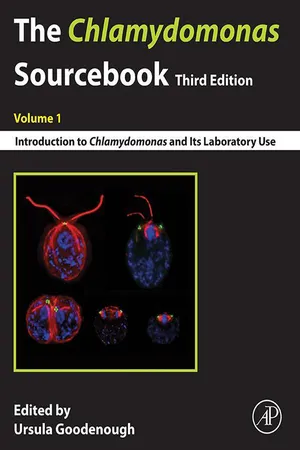
The Chlamydomonas Sourcebook
Volume 1: Introduction to Chlamydomonas and Its Laboratory Use
- 462 pages
- English
- ePUB (mobile friendly)
- Only available on web
The Chlamydomonas Sourcebook
Volume 1: Introduction to Chlamydomonas and Its Laboratory Use
About This Book
The Chlamydomonas Sourcebook, 3rd Edition
Introduction to Chlamydomonas and Its Laboratory Use (Volume 1)
The gold-standard reference?covering the basic biology of the Chlamydomonas alga and techniques for its laboratory analysis
Originally published as the standalone Chlamydomonas Sourcebook, then expanded as the first volume in a three-part comprehensive gold-standard reference,?The Chlamydomonas Sourcebook: Introduction to Chlamydomonas and Its Laboratory Use?has been fully revised and updated to include a?wealth of new resources for the Chlamydomonas community. Early chapters cover current understandings of its taxonomy, ultrastructure, cell and life cycles, and nuclear and organelle genomes, followed by technique-oriented chapters covering such topics as cell culture, mutagenesis, genetic analysis, construction of mutant libraries, and protein localization using immunofluorescence.
This volume presents the latest in research and best practices, making it a must-have resource for researchers and students working in plant science and photosynthesis, fertility, mammalian vision, and biochemistry; crop scientists; plant physiologists; and plant, molecular, and human disease biologists.
- Remains the only complete reference to provide both the historical background and the most up-to-date information and applications on Chlamydomonas
- Includes best practices for applications in research, including methods for culture, genetic analysis, genomic and transcriptomic analysis, and mutant screening
- Helps researchers solve common laboratory problems, provides details on the properties of particular strains, and offers a comprehensive survey of molecular approaches
- Provides a broad perspective for studies in cell and molecular biology, genetics, plant physiology, and related fields
Frequently asked questions
Information
Table of contents
- Cover Image
- Title page
- Table of Contents
- Copyright
- List of contributors
- Preface
- Introduction
- Chapter 1. The genus Chlamydomonas
- Chapter 2. Cell ultrastructure
- Chapter 3. Cell walls
- Chapter 4. Functional genomics of Chlamydomonas reinhardtii
- Chapter 5. The Chlamydomonas nuclear genome
- Chapter 6. Gene expression: from transcription to alternative splicing
- Chapter 7. Organelle heredity
- Chapter 8. Cell cycle and circadian rhythms
- Chapter 9. The sexual cycle
- Chapter 10. The multicellular relatives of Chlamydomonas
- Chapter 11. Growth techniques
- Chapter 12. Practical aspects of mating and tetrad analysis
- Chapter 13. Genetic transformation of Chlamydomonas nuclear, chloroplast, and mitochondrial genomes
- Chapter 14. Methods for the localization of cellular components in Chlamydomonas
- Chapter 15. Mutagenesis and genome resequencing
- Chapter 16. Generation, storage, and utilizations of mutant libraries
- Chapter 17. Reverse genetics
- Index